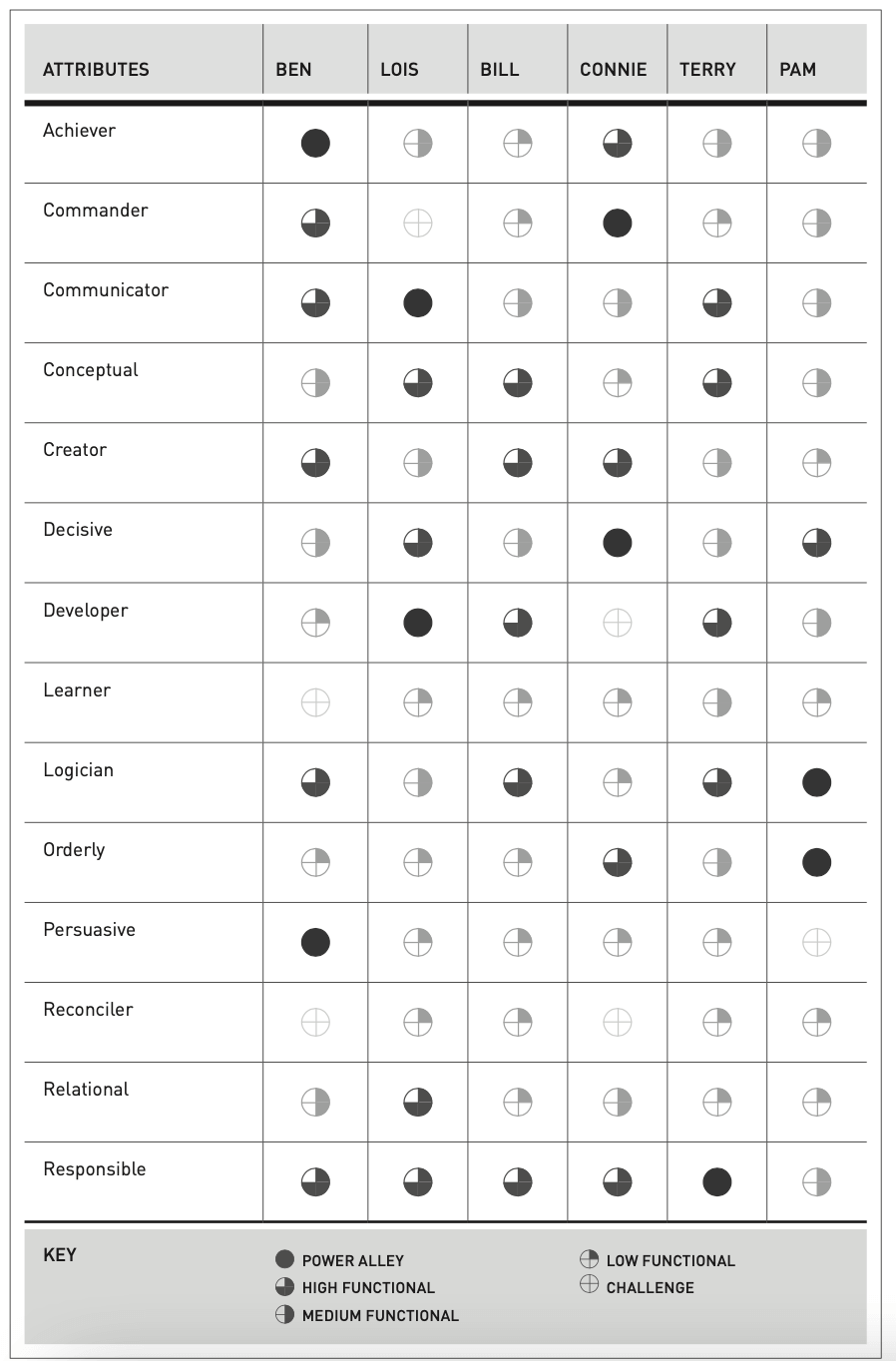Let’s just lay the cards on the table right out of the gate: when it comes to human beings, strengths and weaknesses go hand-in-hand. If I’m strong in X, I’m also weak in Y.
In fact, I’ll go even further, because I’m a lover of history, and I see this time and again in the biographies I read: often, the more powerful a person’s individual traits are, the more pronounced the weaknesses become.
Thomas Edison was so disruptive in his youth that he was expelled after only 3 months of schooling. Steve Jobs was a perfectionist micromanager with almost no empathy toward people. Albert Einstein struggled with quick, automatic responses while in school and was seen as “slow.” Temple Grandin—the PhD and autism activist who revolutionized the handling of cattle in processing plants and is autistic herself—said that our society’s “focus on deficits is so intense and so automatic that people lose sight of the strengths.”
So why were all of these people so successful? They didn’t deny their weaknesses, but they didn’t obsess about “overcoming” them either. Instead, they each chose to focus unapologetically on their natural strengths. And they changed the world.
How can we follow suit? By:
- Embracing the truths of our own natural gifts and weaknesses
- Choosing to focus on our own strengths (hint: this means taking focus off “overcoming” weaknesses)
- Implementing organizational changes that reflect such an attitude
The result is that we don’t just talk the talk, celebrating strengths because it’s popular; we also walk the walk by embracing the realities of weaknesses. In so doing, we free up mental and operational space for the most naturally strong traits to flourish.
Here, I’ll link out to an excellent and very brief interview video on this topic and provide other great resources. First, let’s talk about how an individual can understand and accept his or her strengths and weaknesses, then about how we can (and should!) approach this from an organizational standpoint.
Embracing Natural Attributes
An attribute is an inherent trait. It’s a natural characteristic that can greatly influence your perception of and behavior toward the world around you. Think of your attribute profile as the way you’re wired—the built-in programming of your own internal microchip.
I’ll spoil the end of the story now: you have power-alley attributes as well as challenge attributes. You have things you can do very well, very easily—in fact, you pretty much can’t not do them. You also have things you just don’t do well at all—weaknesses.
The secret to your success lies in focusing on your strengths: work in your power alley, celebrate it, enhance it. That sounds fun, right? But don’t forget what this also means:
The secret to your success also lies I embracing the existence of your weaknesses. Not focusing on them, but recognizing them, identifying them, and choosing to focus elsewhere.
If you don’t embrace your strengths as well as the fact of your weaknesses, you’re faking the whole attributes game. Don’t waste time pretending your weaknesses don’t exist—or pretending that others don’t have them. Those who do this are usually just in denial and likely to waste much time and energy trying to eliminate their challenge areas.
Admit the weaknesses in yourself and others, then redirect your energy toward those natural strengths. This is how mountains are moved.
Accepting Weaknesses in Professional Teams
A healthy company will maintain a culture that not only values a balance of strengths, but also tolerates the natural challenges that all of us have. I love this video clip of David Roche sharing his wisdom about tolerating a diversity of weaknesses within an organization: HBR: “Tolerate Weakness in Your Employees”
If you can’t watch the video now, here are a few quotes:
“It is unobjectionable to talk about having a diversity of strengths. This is the motherhood and apple pie of business. However, I do question how far individual companies really want to push that. Because I think the real question is not diversity of strengths, but it is a tolerance for diversity of weakness. And that is because people who have got great strengths in particular areas…often, that great strength is not balanced by other areas…if you want access to that source of great ideas, you have to be tolerant of the weaknesses.”
“In fact, you need a culture that is integrative of people who have got these sorts of weakness, who are tolerant of one another.”
David Roche
Standing ovation.
Building Teams with Tolerance for Weaknesses
Let’s say you sell cars and I’m in the market. You ask what I’m looking for in my next vehicle, and I say this:
“I need something small and easy to park, with good city mileage for commuting. It also needs to be huge for long family trips and powerful enough to tow my heavy boat, with great fuel efficiency and a loud motor. It should also fly and float.”
No one makes this car. Not even Tesla.
If your ideal candidate for a given position displays every attribute known to man, you need to hear the same thing: God didn’t make this person. He doesn’t make people this way. We each have power-alley attributes; we each have challenge areas.
Just as we need to make choices when selecting a car, regardless of how much we’re spending, we need to make choices when selecting the criteria for any role within our organizations.
Here’s how:
- Define the most important attributes needed for the role
- Write a realistic job description
- As you work to fill the role, focus on those strengths—which means embracing the truth that opposing weaknesses will come with the power alleys
Let’s take it step by step:
The Power of the Attributes Matrix
First, write down the team’s mission and the goals you’re aiming to achieve. Review the overview of attributes, and highlight the 1 – 3 strengths that will best support you in achieving those goals. You can grab a very basic attribute list here:
Once you’ve highlighted your target attributes, get out your attributes matrix. If you don’t have an attribute matrix yet, here’s what you need to know:
In essence, an attribute matrix is like an attribute profile for your entire team. It shows you what (and how many) power-alley attributes you have within the group, what challenge traits you’re dealing with, and so on. It provides visibility into the specific profiles of every person on the team and can allow for a visual representation of how attributes are distributed.
In short, the matrix reveals a team’s power-alley attributes and challenge areas, which in turn unearths opportunities for improved management, balance, and growth. Here’s an example of what an attribute matrix looks like:
Bonus: if you have a copy of Why Make Eagles Swim, flip to chapter 9 to learn more about this incredibly powerful tool. Or reach out to request a custom matrix.
With your attribute matrix created, you can now assess your team in light of the attributes you have covered well, as well as those where you’re a bit weak.
- Look back at your original list of target strengths for this role
- Use your matrix to identify which highlighted attributes are too light on your team
- Identify your top 1 – 2 focus attributes for the new team member.
Reality check: If you ended up with more than 1 or 2 target attributes but are only bringing on 1 new person, you either need to pick your top 2 attribute priorities or bring more people on board. Humans have strengths and weaknesses, which means leaders need to make choices. #SorryNotSorry
If you have trouble choosing, ask yourself this:
If your candidate was high in only 2 things and completely nonfunctional in every other attribute (virtually impossible), then which 2 would you choose?
Job Description
Next, check your job description for opposing attributes.
Looking for someone who can help you discover, create, and evolve big-picture marketing strategies? Then you might need to set aside that perennial favorite of job descriptions: “detail oriented.”
Want to find an analyst who’s going to be fascinated by pulling substantive insights out of your data? There’s a good chance he’s not going to also be a fast decision maker.
Pick the strengths that are essential to the success of the role, drop their opposing attributes, and get results. (Check here for a deep dive on opposing attributes.)
Wisdom on Weaknesses + Much More
It’s very helpful to have some leadership coaching through this process. If you’d like to setup a free intro call to learn more or give it a test drive, please reach out today:
And let me know how it goes!
– Bill






Great video, short and direct to the point!
Agree with the principle. The next step is so critical – make sure you place people in positions where their strengths are needed, where their weaknesses are less relevant and where they have the best chance to excel. This can mean some dramatic changes in responsibilities and can be quite scary for all. Management and employee need to take the leap together when making big career changes for an individual.
Mike, your comments are very insightful. What you describe is a major innovation in the way companies can think and manage people. While the concept might run into resistance in tradition-bound corporations, that doesn’t change the fact that again and again, this approach creates extremely positive reactions throughout organizations. So for those who are toying with this notion, I encourage you to take Mike’s insight, cut through the red tape, and make it happen! You’ll be amazed at the results.
– I’m using a hard copy of your attributes glossary when talking to candidates, and make (+) and (-) signs as we work through the interview. I circle the attribute when I think I have their power alley. When the attributes are really clear, I can actually envision the person interacting with specific team members.
My goal is to understand how the attributes support the skills set. It’s very helpful.
Thanks, Mike, for a great idea! Mike’s is a tool that will help keep you focused on the attribute patterns of a given candidate, and he’s doing exactly the right thing in envisioning how that profile fits the existing team.